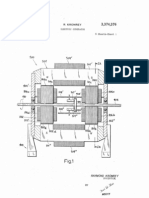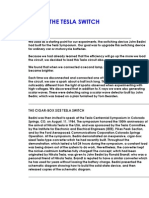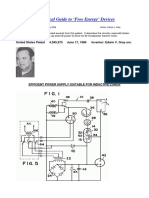Mueller Experiments Kromrey Brandt Tesla Bedini!!!!!
Mueller Experiments Kromrey Brandt Tesla Bedini!!!!!
Uploaded by
d4nk4rCopyright:
Available Formats
Mueller Experiments Kromrey Brandt Tesla Bedini!!!!!
Mueller Experiments Kromrey Brandt Tesla Bedini!!!!!
Uploaded by
d4nk4rOriginal Description:
Copyright
Available Formats
Share this document
Did you find this document useful?
Is this content inappropriate?
Copyright:
Available Formats
Mueller Experiments Kromrey Brandt Tesla Bedini!!!!!
Mueller Experiments Kromrey Brandt Tesla Bedini!!!!!
Uploaded by
d4nk4rCopyright:
Available Formats
Mueller EXPERIMENTS WITH A KROMREY AND A BRANDT-TESLA CONVERTER 1
Experiments With a
Kromrey & a BandtTesla Converter Built
By John Bedini
With Comments by Tom Bearden
EXPERIMENTS WITH A KROMREY AND A BRANDT-TESLA CONVERTER
BUILT BY JOHN BEDINI WITH COMMENTS BY TOM BEARDEN
by Eike Mueller
Published by
P.O. Box 1649
Greenville, TX 75401
TESLA BOOK COMPANY
P O. Box 121873
Chula Vista, GA 91912
1-800-398-2056
Copyright (c) 1984
by
Eike Mueller
T. E. Bearden
John Bedini
All rights reserved.
OCR and editing by lamare, 2009.
Mueller EXPERIMENTS WITH A KROMREY AND A BRANDT-TESLA CONVERTER 2
FOREWORD
Following an invitation by John Bedini, I went with him to Los Angeles immediately
after the Colorado Springs Tesla Symposium on 10-12 August 1984, We had two
days together to work on the Kromrey Converter and the Tesla Switching Device.
One thing came out very clearly: every time when we looked into the "free energy"
all commonly known physical laws are no longer valid. The things happening react
directly opposite to what one would expect. Specifically the more we loaded a
specific circuit, the more output energy we gained, while using a constant input
energy level. I will come back to this effect later, when I describe the experiments in
more details.
At this point I want to take the opportunity and thank John Bedini and his lovely wife
for their hospitality and assistance. It takes persons like John to get the "free
energy" rolling. Without his publication [1] of the detailed plans for his free energy
device, we would definitely not have seen the free energy devices demonstrated
during the Tesla Symposium.
Also many thanks to Tom Bearden, who took his time and explained the results of
the tests performed on 13-14 August 1984. His comments are contained in the
concluding chapter of this report.
Kromrey Converter
John Bedini found that the material generally available concerning Kromrey's
Converter had been altered. Rebuilding the Kromrey Converter from the patent
papers ended up in a non-functioning device. Bedini found the necessary
modifications which made this machine perform.
Our first goal was to determine the converter's efficiency. We found this to be quite
difficult as the efficiency changes with the load applied.
FIGURE K-1 shows the first setup we used. We drove the Kromrey Converter from a
12 V motorcycle battery. We connected at the output of the converter a condenser
and and a rectifier bridge in parallel. The rectified current was then put back into the
motorcycle battery. To detect any current flow, we connect into the positive line a 12
V light bulb.
The result of this test was that the light bulb was lit up. However, after 15 minutes
the battery voltage had dropped from 11.05 V to 9.10 V. The speed of the converter
was stable at 1020 rpm.
[1] "Bedini's Free Energy Generator" by John Bedini, Tesla Book Company, Millbrae,
California 1984
Mueller EXPERIMENTS WITH A KROMREY AND A BRANDT-TESLA CONVERTER 3
FIGURE K-1 KROMREY CONVERTER TEST SETUP 1
In the next test we introduced a separate battery (BATTERY #2) for charging from
the converter.
We recharged the battery #2 from 12.30 V to 12.40 V within 4 minutes, and we
measured a current into battery #2 of 0..8 amperes.
FIGURE K-2 KROMREY CONVERTER SETUP 2
Mueller EXPERIMENTS WITH A KROMREY AND A BRANDT-TESLA CONVERTER 4
PICTURE C-1.1 shows the second test setup. On the left side is the Kromrey
Converter, powered by an electric motor (center). Battery #2 is the battery in the
front (center right) and battery #1 is the one behind it. The voltmeter shows the
voltage of battery #2. The 12 V light bulb is on the table in front of battery #2.
PICTURE C-1.1 KROMREY CONVERTER SECOND TEST SETUP
Because the Kromrey Converter turned too slow on one 12 V battery, we decided to
drive the Converter using 24 V via two 12 V batteries, connected in series. PICTURE
C-1.2 shows this setup.
PICTURE C-1.2
Mueller EXPERIMENTS WITH A KROMREY AND A BRANDT-TESLA CONVERTER 5
Next we wanted to find a correlation between the normal charging of battery #2
using a commercial battery charger, and charging this same battery with the
Kromrey Converter. We drained the battery #2 to 8 V, connected it to the Kromrey
Converter, and after reaching 11.51 V, we measured the time it took to charge the
battery from this voltage level of 11.51 V to 12.45 V. We reached this voltage (12.45
V) after 11 minutes. The indicated current into the battery was 0.94 A.
We then repeated these steps using the commercial battery charger. Because we ran
out of time after nearly 2 hours, we disconnected the battery from the charger. The
battery voltage had reached 12.41 V. The measurement is depicted in FIGURE K-3.
THE BATTERY CHARGER NEEDED 119 MINUTES
TO RAISE THE BATTERY VOLTAGE FROM 11.51 V TO 12.41 V
FIGURE K-3
THE KROMREY CONVERTER NEEDED 11 MINUTES TO RAISE THE BATTERY
VOLTAGE FROM 11.51 V TO 12.45 V
NOTE: The charger could not fill up the batteries
to 12.45 volts within two hours.
We wanted to find the correction factor for the Kromrey Converter by comparing the
same effect, i.e. the charging of the same battery from one specific voltage to
another specific voltage. The calculation of this factor is shown in FIGURE K-4. This
correction factor CK was determined by dividing the area Y (amperes over time, for
charging with the commercial battery charger) through area X (amperes over time,
Kromrey).
FIGURE K-4
TABLE K-l shows the combined test results. Because we detected an increase in the
Mueller EXPERIMENTS WITH A KROMREY AND A BRANDT-TESLA CONVERTER 6
speed of the Kromrey Converter as well as a decrease in the input energy when we
increased the output load, we decided to measure the input energy and speed when
the output was shorted. Again, the input energy dropped and the speed increased.
MEASUREMENT
- INPUT VOLTAGE
25.30
LOADED
WITH
BATTERY
25.00
- INPUT CURRENT
3.90
3.00
2.20
98.67
75.00
54.78
- SPEED IN REV/SECOND
40.00
65.00
73.00
- OUTPUT VOLTAGE (DC)
48.00
10.80
N/A
-OUTPUT CURRENT
N/A
0.95
1.05
N/A
10.26
N/A
WATTS IN...............
WATTS OUT ......................
NO LOAD
WATTS IN/OUT ................. ...................
7.31
SHORTED
CORRECTED
FACT. 5.535
24.90
56.78
1.32
TABLE K-l
Using the earlier determined correction factor of 5.535 we calculated the energy we
put into the battery to 56.78 Watts (from 10.26 * 5.535). Looking at TABLE K-1 we
see that it takes only 54.78 Watts to run the Kromrey Converter when the output is
shorted. This result led us to continue with these tests and load the converter output
even more. The results of these tests can be seen in TABLE E-2 on the next page.
Here again, we detected that we will get a higher efficiency of the total device, the
more we load down the output side. This effect is totally contradictory to the
conventional laws of physics.
Mueller EXPERIMENTS WITH A KROMREY AND A BRANDT-TESLA CONVERTER 7
MEASUREMENT
- INPUT VOLTAGE INPUT CURRENT
NO LOAD LOADED WITH LOADED
WITH LOADED WITH LAM & BATT.
RESISTOR RESISTOR
13.5 OHM 0.63 OHM
25.40
25.30
20.00
21.90
3.90
3.90
3.39
2.30
WATTS
IN...................
... 99.06
67.80
50.37
- OUTPUT VOLTAGE
[DC] - OUTPUT
CURRENT RESISTANCE [OHM]
48.00 N/ 28.00
A
0.75
50.00
13.50
20.00
0.63
WATTS
OUT..................
WATTS OUT
(CORRECTED)......
WATTS
IN/OUT .............
... N/A
21.00
185.19
116.24
634.52
0.85
0.08
0.37
TABLE K-2
We used the Kromrey correction factor for the first case, when we had connected the
battery to the converter output. We did not use this factor in both other cases when
we used resistors in the output circuit.
These above test results show that the efficiency of the Kromrey Converter is well
above 100%.
The Brandt-Tesla Switch
We used as a starting point for our experiments, the switching device John Bedini
had built for the Tesla Symposium (FIGURE T-1). Our goal was to upgrade this
switching device for ordinary car or motorcycle batteries.
To get a better understanding of this system, we first built only one half of the
circuit, FIGURE T-2 shows our first arrangement.
Mueller EXPERIMENTS WITH A KROMREY AND A BRANDT-TESLA CONVERTER 8
FIGURE T-1
Mueller EXPERIMENTS WITH A KROMREY AND A BRANDT-TESLA CONVERTER 9
FIGURE T-2
TO RAISE THE VOLTAGE FROM 11.51 V TO 12.45 V TOOK 5 SEC.
COMPARE THIS RESULT WITH TESTS # 3 AND 5. FIG. K-4
NOTE: 1 OHM RESISTOR REMAINED COLD AFTER 15 MIN. RUN TIME.
Using the setup shown in FIGURE T-3, we performed the same kind of test we did
earlier, using the Kromrey Converter. This time we used a 12 V battery with one
dead cell as if it were a 10 Volt battery (dead cell not in the loop). The supplying
battery was a freshly charged 12 V battery.
In the first step we drained the 10 V battery. When we connected this battery to the
conventional battery charger it showed a voltage of 1,7 Volts. After 12 minutes 20
seconds we had reached a voltage level of 10.24 Volts.
Again, we drained the battery and then connected it to the Brandt-Tesla Switch.
After 1 minute and 24 seconds we had reached 10.24 Volts. We detected that the
temperature of the battery was higher than it was before, when we had used the
conventional battery charger.
FIGURE T-3
TO RAISE THE VOLTAGE FROM 1.7 V TO 10.24 V TOOK 1 MIN 5 SEC.
NOTE. 1 OHM RESISTOR REMAINED COLD AFTER 15 MIN. RUN TIME.
Mueller EXPERIMENTS WITH A KROMREY AND A BRANDT-TESLA CONVERTER 10
Because we had already learned that the efficiency will go up the more we load the
circuit (see TABLE K-2), we decided to load this Brandt-Tesla circuit also. We
modified our test setup slightly by introducing amperemeters and two light bulbs. A
110 V, 40 W bulb was used on the secondary side of the transformer, and a 12 V,
280 W quartz lamp was connected in parallel with the 10 V battery. FIGURE T-4
shows the arrangement and the currents we measured. Again, we found that when
we connected the quartz lamp, the 110 V light instantenuously became brighter.
FIGURE T-4
PICTURE C-2.1 shows this experiment. The quartz lamp is on top of the 10 V battery
and the 110 V light bulb is in front of the transformer.
PICTURE C-2.1
Mueller EXPERIMENTS WITH A KROMREY AND A BRANDT-TESLA CONVERTER 11
When we compare all the measured values we get the following table:
CURRENT FLOW FROM THE 24 V
BATTERY:
CURRENT FLOW INTO 10 V BATTERY:
INTO QUARTZ LAMP:
40 WATTS 110 V LIGHT BULB;
4.0
A AT
24.0 V
---> 96 WATTS
5.5 A AT
30.0 A AT
10.6 V
9.0 V
---> 58 WATTS
---> 270 WATTS
---> 40 WATTS
WATTS IN/OUT = 96/368 = 0.26
Every time when we disconnected and connected the 110 V light bulb in the setup as
shown in FIGURE T-4 we saw a spark about a half-inch long. The light of this spark
was noticably different from the light of sparks observed when experimenting with
high voltages. PICTURE C-3 shows such a spark. We discovered that in addition to Xrays we were also generating scalar waves. These were detected using a scalar wave
detector built by John Bedini, which was based on a plan by Tom Bearden.
PICTURE C-3
Mueller EXPERIMENTS WITH A KROMREY AND A BRANDT-TESLA CONVERTER 12
Simplified Diagrams
At the end of this report I now show two simplified switching diagrams. These have
been modified from the original diagram of Mr. Ronald Brandt which was given to
John Bedini. Ken Moore and I updated the original diagram to make it more
understandable to the layman.
FIGURE T-5 Original Diagram of Mr. R. Brandt
FIGURE T-6 shows how a circuit can work using three double-pole relay switches
driven by a pulse rate generator (ten Moore).
FIGURE T-6
FIGURE T-7 shows the circuit diagram for a setup using MJ802 power transistors
driven by a rotary switch or electronic timer.
Mueller EXPERIMENTS WITH A KROMREY AND A BRANDT-TESLA CONVERTER 13
FIGURE T-7
Ken Moore
Mueller EXPERIMENTS WITH A KROMREY AND A BRANDT-TESLA CONVERTER 14
COMMENTS BY TOM BEARDEN
- The Observation/Detection Process From the standpoint of modern physics, the "universe" we detect, measure, and see
is always the "output" of an interaction between the detector/observer and "that
unobserved reality" that is really there before the interaction. The "basic reality,
before observation/detection" is comprised of something referred to as "action,"
having the units of angular momentum. That is, unobserved reality is composed of
"energy multiplied by time," or "momentum multiplied by length," or the product of
two other "locked together" (canonical) variables.
The best way to visualize a photon -- the basic electromagnetic quantum is to
think of it as "a little piece of energy welded to a little piece of time," with no seam in
the middle. In other words, the photon is a sort of "fusion of energy and time,
without separation in any fashion." When we speak of "energy," ultimately we speak
of photon exchange, whether the photons are "virtual" (smaller than can be
individually detected) or observable (large enough to be individually detected).
Even with the macroscopic mechanical interactions, ultimately the forces are
generated not by colliding objects but by exchange of virtual photons, in the view of
modern quantum physics.
At any rate, when we make a "detection," the smallest amount of change involved in
the unobservable universe is one "quantum" of action. However, we do not actually
detect a whole quantum: instead we detect one piece of the quantum and lose the
other piece. In other words, if we detect all the little piece of energy in the quantum,
we lose all the little piece of time. If we detect a little piece of momentum, we lose
all the little piece of length. The point is, one can imagine that we "split" or "fission"
the quantum when we "detect", and we only detect one part of it. FIGURE 1 shows
the operation of the detection process. Specifically, according to quantum mechanics
we can never directly detect or observe the piece of "time" at all. Time is not
observable, even in principle, in quantum mechanics.
In my first crude paper along these lines[1], I pointed out that quanta do not
superpose; instead, a single quantum change occurs at a time, and a single
detection occurs at a time. In conceptually modeling the fundamental detector itself,
it was necessary to utilize a "fusion" process on the fragments of the quantum
resulting front the fission/detection process. In other words, one has to clear out the
residue before another "fragmenting" can occur. The way this happens is that the
two pieces are fused together, back into a full quantum, disappearing into the basic
action continuum.
Thus the passage through time of a body occurs in little time jumps. (FIGURE 2).
And each little piece of time helping to make an individual jump is removed before
the next jump occurs. That is, our march through time is not at all through a
continuous time dimension as
Mueller EXPERIMENTS WITH A KROMREY AND A BRANDT-TESLA CONVERTER 15
Minkowski space time and relativity model it. Instead, we march through time like a
peculiar sewing machine, one stitch at a time, and each stitch made is removed
before the next one is made. This explains precisely why we cannot "see through
time" as we see along the physical dimension. The time dimension is continually
fragmented and destroyed.
FIGURE 1. The Operation of Physical Detection at the Quantum Level.
FIGURE 2. Passage of Object Through Time Occurs in Discrete Jumps
FIGURES 1 and 2 show the situation, Note that we can consider the "successive
ripping out of time stitches" as the negative stream of time.
Mueller EXPERIMENTS WITH A KROMREY AND A BRANDT-TESLA CONVERTER 16
Mueller EXPERIMENTS WITH A KROMREY AND A BRANDT-TESLA CONVERTER 15
In this model, everything exists in both positive and negative time streams that
usually are balanced. In this fashion, a completely new definition of mass was
obtained, Newton's laws of motion (relativistic form) were derived, and the square
law of gravitation was derived, albeit crudely. [2]
Now notice that, when an action quantum is split into conceivable energy and time, it
may be split in two ways: a) it can be split intopositive pieces of energy and positive
pieces of time, or b) it can be split into a negative piece of energy and a negative
piece of time. FIGURE 3 shows these possibilities of splitting. Note that, if we
consider both the fission and fusion processes, both splits actually occur, depending
upon which time stream one chooses to observe from.
FIGURE 3. Two Possibilities of Action Quantum Fissioning
This is most interesting. We now have a concept whereby each object is passing
through both the negative time flow and the positive time flow in an interweaved
manner; to the macroscopic observer, this appears to
be simultaneously.
So an object may be said to possess both positive and negative energy,
simultaneously, as a first order approximation. It possesses positive energy in
positive time, and negative energies in negative time. In all normal processes, we
have considered and developed only positive time processes. However, we point out
that negative time operation is well-known in modern physics. Feynman diagrams
involve extensive negative time travel. Originally Dirac did not predict the positron as
a positive particle travelling forwards in positive time. Instead, he predicted a
negative particle (traveling in negative time, in our
Mueller EXPERIMENTS WITH A KROMREY AND A BRANDT-TESLA CONVERTER 17
view), which we could only observe (with positive time instruments!) as a positive
particle traveling forwards in time. In the view of modern physics, real particles
already travel backwards in time sometimes.
But if we can actually produce some extra negative time in a device which normally
is observed only to produce positive time, we shall obtain a reversal of entropy.
Systems which tend to disorder in positive time, tend to order in negative time. Such
an effect (production of negative time) involves the concomitant production of
negative energy. However, negative electromagnetic energy will still run motors and
burn light bulbs. The photon, you see, is its own antiparticle: and an antiphoton is
just observed as another photon.
We will choose to regard an antiphoton as consisting of negative energy and
negative time, and producing these two fragments if detected in the laboratory
frame. The production of antiphotons and negative time will yield negentropy and
additional or "free" negative energy, appearing to us to violate the ordinary
"conservation of energy" law. This is no problem; production of unbalanced time
streams, and hence the appearance of negative energy and negative time, is itself a
"curved spacetime" phenomenon. Any system exhibiting this effect is existing in a
locally curved spacetime (FIGURE 4). That Is, it is now a general relativistic system,
and energy need not locally be conserved. The system can appear to contain either a
source or a sink, depending upon the individual system's functioning, to an external
laboratory observer. We will return to this effect shortly.
Note the two time lines are of equal length. The negentropy device is producing
negative energy and negative time, with respect to the lab observer.
FIGURE 4. Production of Negentropy by Local Curvature of Spacetime Vacuum
Mueller EXPERIMENTS WITH A KROMREY AND A BRANDT-TESLA CONVERTER 18
Three Kinds Of Electromagnetics
There are actually three types of electromagnetics (TABLE 1), as I pointed out in ray
paper [3] to the IEEE Colorado Springs Tesla Centennial Symposium on 11 August
1984:
a) The ordinary kind of EM, described in classical electromagnetic theory. In classical
EM theory, the vector force fields are considered primary and causative, and the
potentials are considered to be only mathematical figments. In a region where the
force fields are zero, classical EM theory assumes that all the electromagnetic effects
cease.
b) Quantum mechanics, which holds quite a different view of EM, In QM theory the
potentials are considered to be real and fundamental, and the EM force fields are
merely created from them by differentiation. That is, QM considers the force fields
such as E and B to be derived effects, not fundamental causes. Further, when these
derived force fields are zero, this only means that the gradients of the potentials are
horizontal and hence "zero vectors." The potentials are still there, however, and their
interference in a region of zero EM force fields can and does still cause effects. Thus,
when classical EM effects reduce to zero, QM EM effects can still exist due to the
potentials. In addition to violating classical EM theory, this also violates classical
mechanics. It is true and experimentally proven nonetheless. [4] [5]
c) An extension to the EM view of quantum mechanics, which I have named "scalar
electromagnetics." The view of a potential by QM is essentially that it is composed of
randomly fluctuating little virtual flux vectors, each representing a moving virtual
particle and hence a moving virtual force. That is, QM fundamentally assumes that
the virtual vector substructure comprising a potential stress of spacetime is totally
statistical and sums to zero. My own contribution, arrived at hy noting the work of
many unorthodox researchers, is to point out that the virtual substructure need not
be random at all. We can simply form EM force field vector zeros by opposing or
summing ordinary E and B vectors, for instance, to a zero vector. In this case, the
sum of the absolute values of their magnitudes represents an artificial potential, an
artificial stress in spacetime, but one that now has a rigorously deterministic
substructure. This represents a deterministic ordering placed into the virtual state
(inside the zero vector, in its substructure). We have therefore violated one of the
fundamental assumptions of quantum mechanics. We have deliberately ordered and
formed the stress of spacetime itself. In other words, we have accomplished general
relativistic warping or curving of spacetime as we deliberately chose, and partially
ordered the otherwise statistical disorder of the virtual-flux vacuum-ether. The third
kind of electromagnetics allows us to transcend many of the limitations of classical
EM and of quantum mechanics.
Mueller EXPERIMENTS WITH A KROMREY AND A BRANDT-TESLA CONVERTER 19
TABLE 1 THREE KINDS OF ELECTROMAGNETICS
CLASSICAL
-> POTENTIALS JUST MATHEMATICAL CONVENIENCES
-> ACTIONS CAUSED BY NONZERO FORCE FIELDS
-> NO ACTION WHEN FORCE FIELDS ZERO
QUANTUM MECHANICS
->
->
->
->
POTENTIALS REAL
STATISTICAL SUBSTRUCTURE
FORCE FIELDS BY DIFFERENTIATIONS
ACTIONS WHEN FORCE FIELDS ZERO
ARTIFICIAL POTENTIALS
->
->
->
->
->
POTENTIALS REAL
FORCE FIELDS EXTERNALLY ZEROED, INTERNALLY ACTIVE
ZEROS INDIVIDUALLY DIFFER
SCALAR INTERFEROMETRY
SCALAR RESONANCE
TABLE 2 shows the specific characteristic features of each of the three kinds of
electromagnetics. The first two EM's are already proven; the third follows by simple
summation of ordinary force field vectors to zero, to produce artificial potentials.
Note what an astounding change this simple vector summation-to-zero, to make an
artificial potential, represents to physics. In deliberately forming order in what was
previously vacuum disorder, we have accomplished -- simply and directly -- the
production of negentropy. We have reduced disorder and increased order.
If so, we must inevitably have produced negative time and negative energy, as seen
by the external, linear laboratory observer, as was shown in FIGURE 4.
Mueller EXPERIMENTS WITH A KROMREY AND A BRANDT-TESLA CONVERTER 20
TABLE 2 COMPARISON OF EM CONCEPTS
Theory
Classical EM Present linear
Scalar EN
Characteristic
Quantum Mechanics (Artificial 0)
Vacuum
spacetime
Linear no
charge
Linear. Charged
(virtual)
statistically.
Nonlinear.
Charged (virtual)
with deterministic
components.
virtual
substructure
none
(fluid
equations)
yes statistical
force in
vacuum?
cause yes
effect
yes
yes, statistical
but
deterministically
weighted
effect no
ZERO
force fields
no effect
Bohm-Aharonov
effects
substructure
effects
engineerable
potentials
ficticious
real, primary
statistical
substructures
real, primary
deterministic
causative
agent
force fields
potentials
potentials and
infolded fields of
substructures
charge
with mass
with mass
massless
relativistic
effects due to
velocity
velocity, interfering interfering
potentials
potentials
hidden
variables
no
statistical negligible deterministic,
major role
vector theory
applied to EM
okay
okay
requires revision
vacuum EM
wave
transverse
transverse
longitudinal with
swirls
energy/mass
conservation
yes
yes
charge
conservation
yes
yes
not necessary,
anenergy
conserved
not necessarily
Mueller EXPERIMENTS WITH A KROMREY AND A BRANDT-TESLA CONVERTER 21
TABLE 2 ( continued) COMPARISON OF EM CONCEPTS
Theory
Classical
Present linear
Scalar EM (Artificial
Characteristic
Quantum
0)
Mechanics
action at a
no
no, except
yes, scalar
distance
Bohm-Aharonov
interferometer
scalar (zerovector)
resonance
no
no
yes
inertia is
electrical
no
no
yes
gravity is
electrical
no
no
yes
mass is
electrical
no
no
yes
Negative Time Effects
Eike Mueller's tests of John Bedini's free energy devices directly demonstrate the
effects of the production of negative time. That is, the Bedini devices produce some
negative time and negative energy, during any macroscopic interval in which they
produce positive time and positive energy.
For example, in all three devices Bedini has built to date, a battery is used as an
accumulator for the energy, whether it be positive energy or negative energy. By
feeding back some "negative potential current" (or -dot) to the battery, the battery
accumulates and charges up with negative timespace energy. The battery can
furnish the extra negative energy to motors and light lights, with certain peculiarities
to be mentioned shortly.
First, however, a most unusual effect occurs in the battery. Note that in modern
theory the vacuum is considered to be filled with little "holes" or negative energy
states, each normally filled by an electron. (FIGURE 5). This "sea of little negative
energy electrons in holes" is called the Dirac sea, after the eminent scientist P.A.M.
Dirac, who conceived the theory.
Mueller EXPERIMENTS WITH A KROMREY AND A BRANDT-TESLA CONVERTER 22
FIGURE 5, The Normally-Filled Dirac Sea
Now, in the negative time portion of the machine's operation, we shall consider that
the Dirac sea is inverted. That is, the negative energy electrons will now "fall out of"
the holes during the negative time portions, producing negative energy. This of
course is real energy, and drives motors and lights. However, a battery which has
been charging with negative energy has accumulated a pool of emptied holes in its
Dirac sea (FIGURE 6). Everything seems normal, until we remove the battery from
the negative-entropy device and hook it up to a normal battery charger. Now we find
an amazing effect: the battery will at first "eat" or consume electricity, while the
electrons in the charging current are filling the empty Dirac holes. During this filling
time, the battery will not recharge to recover its voltage. After these Dirac holes
have been filled again with electrons, the battery will start to charge up normally,
and will contain normal, positive energy when charged (FIGURE 7).
6. The Partially-Emptied Dirac Sea
FIGURE 7. Filling The Dirac Sea Holes
FIGURE
Mueller EXPERIMENTS WITH A KROMREY AND A BRANDT-TESLA CONVERTER 23
On one test, a Bedini battery removed from the operating Kromrey-type device
consumed electrical current for 110 minutes before the Dirac holes were filled and
the battery started to charge normally.
At the Colorado Springs Tesla Centennial Symposium, the battery from Jim Watson's
Bedini-type free-energy device was stolen probably by agents who know of the
effect, and wanted to see if the battery exhibited the "Dirac fill time" effect. That is,
they could absolutely ascertain whether or not his device was real, simply by testing
the battery to see if it exhibited the effect.
On any free-energy device which is powered from a recharging battery, this is a
positive test to ascertain whether the device is genuine or a fake.
Other negative time effects are evidenced by a motor running at least partially on
negative energy. The way to understand these effects is to reverse in our minds
what would happen to a normal motor
running on positive energy and positive time.
For example, one may visualize a motor running at constant speed as containing
some constant value of energy at any given time. If all the energy is positive and the
time passing is positive, when one shorts the terminals one removes positive energy.
The motor thus dies. On the other hand, if the motor contains a negative energy and
negative time, shorting the terminals removes negative energy and negative time.
This is equivalent to increasing negative energy in positive time. Therefore the
laboratory observer will observe the motor to increase its speed when the terminals
are shorted. Eike Mueller directly observed this effect in the Bedini device.
Similarly, if one adds additional loads to a negative energy/ negative time motor,
one is again removing negative energy and negative time, which is identical to
adding negative energy in positive time. Thus again the motor increases its speed
precisely as Eike Mueller's tests showed.
Additional negative time effects are exhibited. Utilization of negative energy
produces IF cooling instead of heating. Thus resistors and semiconductors run cold.
The more load added, the more negative energy current drawn and devices get
cooler, even though the lights get brighter and the motor runs faster. Also, to the
negative energy/negative time operation, the frequency/temperature spectrum
appears to be inverted. That is, instead of "heating up" through infrared, into visible,
into ultraviolet, and into X-rays and gamma rays, the negative energy device
exhibits "cooling down" from gammas to X-rays to visible to infrared. In this manner
one finds that a simple low voltage (positive instrument measurement!) spark
exhibits profoundly unusual effects: Its negative time/negative energy/"vol-tage"
may be extremely high . The spark therefore may appear of extraordinary length for
the (seemingly) low voltage indicated by posi-
Mueller EXPERIMENTS WITH A KROMREY AND A BRANDT-TESLA CONVERTER 24
tive-time instruments. In addition, the spark may be unusually rich in UV emission or
X-ray emission. For uncontrolled very high-energy negentropy devices, even gamma
emission may be observed from seemingly "low voltage" devices. The long-sought Xray laser and gamma ray laser should be easily constructable along negative entropy
device principles.
These are just some of the exciting effects that have become apparent in the
negentropy devices built by John Bedini. Further, John has magnanimously released
sufficient details so that other experimenters can produce working models of two of
his devices. Jim Watson has already successfully replicated the first Bedini motor,
and scaled it up into a much larger device. In addition, Eike Mueller himself has
replicated a simplified version of Bedini's Tesla switch device.
We are on the threshold of a new science, a new world, and a new life, given to us
by the pioneers such as Tesla, Moray, Bedini, and others.
Let us get on with it and put it to immediate use to power our cities, our homes, and
our industries.
References
[1]
Bearden, Thomas E., "Quiton/Perceptron Physics:
A Theory of Existence, Perception, and Physical Phenomena,"
March, 1973, NTIS # AD 763210
[2]
Ibid.
[3]
Bearden, Thomas E., "Tesla Electromagnetics and Its Soviet
Weaponization," presented to the IEEE Tesla Centennial Symposium,
Colorado College, Colorado Springs, Colorado 11 August 1984
[4]
Y. Aharonov and D. Bohm, "Significance of Electromagnetic
Potentials in the Quantum Theory," The Physical Review, Second
Series, 115 (3), August 1, 1959, pp. 485-491.
[5]
R.G. Chambers, Phys. Rev. Lett., Vol.5, 1960, p.3.
Mueller EXPERIMENTS WITH A KROMREY AND A BRANDT-TESLA CONVERTER 25
ADDITIONAL TESTS BY EIKE MUELLER
30 August / 1 September 1984
In the first series of tests I used the rotary switch. The batteries were labeled as #1
and #2 (left side) and #3 and #4 (right side).
Here are the major events.
EVENT 1 Start at 12:25 pm; voltage measurements taken,
EVENT 2 At 12:45 pm voltage measurements taken.
EVENT 3 At 1:00 pm the 12V, 75W lamp replaced by a 110/10V transformer.
EVENT 4 At 1:15 pm voltage measurements taken.
EVENT 5 At 1:30 pm test stopped, voltage measurements taken.
TABLE 1 shows the detailed voltage measurements during the conduct of
this test.
TIME
EVENT
VOLTAGE
BATT.#1
BATT.#2
BATT.#3
BATT.#4
12:25
1
12:45
2
1:00
3
1:15
4
1:30
5
12.0
11.9
12.2
12.2
12.0
11.9
12.1
12.2
12.1
12.2
12.7
12.7
12.1
12.2
12.8
12.7
12.1
12.2
12.8
12.8
TABLE 1 TESLA/BRANDT/BEDINI SWITCHING DEVICE FIRST SERIES
PICTURE 1 shows the conduct of this test. The batteries were labeled from #1 to #4
from left to right. In the center the rotary switch, and to the left of it the
potentiometer for its speed control (frequency control of circuit), can be seen. To the
right of the rotary switch is the relay which switches the battery banks. To the right
of the relay is the 12 V, 75 W quartz lamp which is connected to the negative
terminals of batteries #2 and #4.
Mueller EXPERIMENTS WITH A KROMREY AND A BRANDT-TESLA CONVERTER 26
PICTURE I FIRST SETUP OF TESLA SWITCH EXPERIMENT
At 3:00 pm the Tesla switch was reconnected. This time the relay was driven by the
timer which was built by Louis Pollaehn of COMTEC. FIGURE 1 shows the circuit
diagram for this timing device and PICTURE 2 shows the solid state timing device in
operation.
FIGURE 1 CIRCUIT DIAGRAM OF TIMING DEVICE BY LOUIS POLLAEHN
Mueller EXPERIMENTS WITH A KROMREY AND A BRANDT-TESLA CONVERTER 27
PICTURE 2 THE SOLID STATE TIMING DEVICE IN OPERATION
Test history:
EVENT A
At 3:10 pm test started, load was a 110/10 V transformer between the
two negative terminals of batteries #2 and #4. The secondary side the
transformer was connected to two 4OW, 110V light bulbs in parallel.
EVENT B
At 4:00 pm voltage measurements taken.
EVENT C
At 4:30 pm a small 110 V fan was added in parallel to the two 110 V
light bulbs.
EVENT D
At 5:40 pm a 12 V, 75 W quartz lamp was connected to battery #1.
EVENT E
At 6:00 pm voltage measurements taken. PICTURE 3 shows this setup.
At left is the quartz lamp connected to battery #1, In the center
foreground are the two incandescent lamps. To the right of the lamps
is the 110 VAC fan. Behind the fan and out of sight is the relay. Next is
the 110/10 V transformer, hooked up to the two negative terminals of
batteries #2 and #4, The solid state timing device is located between
the transformer and battery #4,
Mueller EXPERIMENTS WITH A KROMREY AND A BRANDT-TESLA CONVERTER 28
PICTURE 3 Tesla/Brandt/Bedini Switching device loaded with
two 110V light bulbs, 110V fan and a 12V 75W quartz lamp.
EVENT F
At 6:30 pm voltage measurements taken.
EVENT G
At 7:00 pm one 110 V light bulb disconnected.
EVENT H
At 7:25 pm the same 110 V light bulb connected back into the circuit.
TABLE 2 shows the results of this test.
TIME
EVENT
VOLTAGE
BATT.#1
BATT.#2
BATT.#3
BATT.#4
3:10
A
4:00
B
4:30
C
5:40
D
6:30
F
7:00
G
7:25
H
12.0
12.1
12,3
12,3
12.3
12,5
12.7
12,7
12.3
12.5
12.6
12.6
12,3
12.4
12.5
12.5
12.2
12.2
12.4
12.4
12.1
12.1
12.5
12.5
12.0
12.1
12.4
12,4
12.0
12.1
12.4
12.4
TABLE 2 TESLA/BRANDT/BEDINI SWITCHING DEVICE SECOND SERIES
Mueller EXPERIMENTS WITH A KROMREY AND A BRANDT-TESLA CONVERTER 29
TABLE 3 shows the continuation of above measurements.
Here again first the events:
EVENT I
8:30 pm voltage measurements taken.
EVENT J
9:15 pm voltage measurements taken.
EVENT K 1
0:30 pm voltage measurements taken.
EVENT L
11:05 pm voltage measurements taken.
EVENT M
11:30 pm voltage measurements taken.
EVENT N
10:30 am (1 Sep) discovery after unit has been operated during
all night that both 110 V lamps were out and that one wire was
broken due to overheating. Voltage measurements taken.
EVENT 0
11:30 am voltage measurements taken.
EVENT P
3:00 pm all lights again out, voltage measurements taken. The low
voltage of battery #2 - marked with (*) in the TABLE 3 - is most
probably caused by the back EMF from the transformer. The ideal
tranformer would be an inverter transformer 10 V to 110 V.
The summary of this test can be seen in TABLE 3 which is a direct continuation of
TABLE 2.
TIME
EVENT
VOLTAGE
BATT.#1
BATT.#2
BATT.#3
BATT.#4
8:30pm
I
9:15 10:30
J
K
11:05
L
11:30
M
10:30am
N
11:30
D
3:00pm
P
11,7
12.1
12.4
12.4
11.8
12.0
12.4
12,5
11.8
11.9
12.5
12.4
12.0
11.7
12.5
12.5
12.5
12.5
12.5
12,5
12.5
12.5
12.5
12.5
12.0
5.0 (*)
12.5
12.0
12,0
12,1
12,4
12.5
TABLE 3 CONTINUATION OF MEASUREMENTS SHOWN IN TABLE 2
The total test run is summarized in GRAPH 1 on the following page. In this graph I
show the voltages of all batteries over the test time in hours.
Mueller EXPERIMENTS WITH A KROMREY AND A BRANDT-TESLA CONVERTER 30
Mueller EXPERIMENTS WITH A KROMREY AND A BRANDT-TESLA CONVERTER
GRAPH 1 TESLA/BRANDT/BEDINI SWITCHING DEVICE TEST SUMMARY
You might also like
- ERR Power Station Project BookletDocument18 pagesERR Power Station Project BookletAnonymous C0KBah6TEqNo ratings yet
- Akula RomanDocument5 pagesAkula Romandllabarre100% (1)
- LEGO Mindstorms NXTDocument11 pagesLEGO Mindstorms NXTAntonis TzilivakisNo ratings yet
- Study Plan For Graduate StudiesDocument3 pagesStudy Plan For Graduate StudiesIshfaq Ahmad100% (2)
- Build A 3-Band Shortwave Converter For Your CarDocument2 pagesBuild A 3-Band Shortwave Converter For Your Carbobbyunlock100% (1)
- Zilano Update May 11 UpdateDocument124 pagesZilano Update May 11 UpdateFiditti100% (8)
- Radiant Energy and Overunity 3Document9 pagesRadiant Energy and Overunity 3Zdenko PopNo ratings yet
- Horary AstrologyDocument8 pagesHorary Astrologymathurastro6645100% (1)
- Design Optimisation of Space Frame ChassisDocument40 pagesDesign Optimisation of Space Frame Chassisadj adj100% (1)
- Level of Satisfaction To The Service and Response of Police Officers of The Residence in A Barangay in Bacolod CityDocument6 pagesLevel of Satisfaction To The Service and Response of Police Officers of The Residence in A Barangay in Bacolod CityKeil Ezon GanNo ratings yet
- A Compilation/Summary of Devices That Produce Over Unity - Rough ResearchDocument20 pagesA Compilation/Summary of Devices That Produce Over Unity - Rough ResearchCris VillarNo ratings yet
- The Stubblefield PapersDocument18 pagesThe Stubblefield PapersMihai Daniel100% (2)
- Tesla-Moray - The Secret of The Joe CellDocument22 pagesTesla-Moray - The Secret of The Joe Cellsonja_Žarić100% (1)
- Bearden - Electret - What It Is and How It Works (2005) PDFDocument4 pagesBearden - Electret - What It Is and How It Works (2005) PDFUn Chubacca YetiNo ratings yet
- Gunderson Solid State Electric Generator Patent US7830065Document9 pagesGunderson Solid State Electric Generator Patent US7830065Dan Beeson100% (2)
- Zilano Diagrams and Circuits For Study of Zilano Posts1Document29 pagesZilano Diagrams and Circuits For Study of Zilano Posts1Sebastian Gonczarek100% (1)
- Hector's Posts - Volume 4, 1 Edition Editor's NoteDocument63 pagesHector's Posts - Volume 4, 1 Edition Editor's NoteVincent J. Cataldi100% (1)
- Lab Notes Transcribed - Floyd SweetDocument15 pagesLab Notes Transcribed - Floyd Sweethyiq50% (2)
- The Hubbard Energy Transformer by Gaston BurridgeDocument8 pagesThe Hubbard Energy Transformer by Gaston Burridgevictor munteanNo ratings yet
- The Stubblefield PapersDocument18 pagesThe Stubblefield PapersDan Beeson100% (2)
- Welcome To John Bedini S Web PagesDocument590 pagesWelcome To John Bedini S Web PagesKatamba Rogers100% (2)
- Vacuum Triode Amplifier - Floyd SweetDocument15 pagesVacuum Triode Amplifier - Floyd SweetharishkumarsinghNo ratings yet
- Townsend DischargeDocument4 pagesTownsend DischargeRonald Malave100% (2)
- Flybackdriver Manualrev2Document25 pagesFlybackdriver Manualrev2gigi_shmenNo ratings yet
- BiFilar Coil As CapacitorDocument3 pagesBiFilar Coil As Capacitordllabarre50% (2)
- Radiant Energy Antenna SystemDocument9 pagesRadiant Energy Antenna Systemsuso73100% (2)
- Kromrey Converter US3374376Document8 pagesKromrey Converter US3374376kishbud100% (1)
- A Special Case of Voltage Gain - Olicer Nichelson - VOLTGNDocument2 pagesA Special Case of Voltage Gain - Olicer Nichelson - VOLTGNDra_en_Ku_mi__5308No ratings yet
- Space Radiant Energy ReceiverDocument5 pagesSpace Radiant Energy ReceiverfghjhgfNo ratings yet
- Anti-Lenz - Anti-LenzDocument6 pagesAnti-Lenz - Anti-LenzTomislav JovanovicNo ratings yet
- Bedini SG: The Complete, Beginner's HandbookDocument8 pagesBedini SG: The Complete, Beginner's HandbookAhmad AriesandyNo ratings yet
- Roschin PDFDocument28 pagesRoschin PDFtomNo ratings yet
- Chapter 3Document135 pagesChapter 3kasperetoNo ratings yet
- And 1he ''Phii - Adelphia Expfriment': Negative TimeDocument94 pagesAnd 1he ''Phii - Adelphia Expfriment': Negative TimegospodarmunjaNo ratings yet
- (Ebook Science - PDF) Nikola Tesla Electric Car Part-2Document9 pages(Ebook Science - PDF) Nikola Tesla Electric Car Part-2dag57100% (2)
- William Alek - Building Free Energy and Exotic Propulsion Devices That Use Gravimetric Mass FluctuationsDocument54 pagesWilliam Alek - Building Free Energy and Exotic Propulsion Devices That Use Gravimetric Mass FluctuationsGoreci AlexNo ratings yet
- The Tesla SwitchDocument8 pagesThe Tesla SwitchJan Groenewald100% (1)
- Magnetic Resonance AmplifierDocument95 pagesMagnetic Resonance Amplifierspicerw100% (2)
- Coler Magnetic Current ApparatusDocument11 pagesColer Magnetic Current ApparatusbluesurviverNo ratings yet
- Homopolar GeneratorDocument5 pagesHomopolar GeneratorBoreda Rahul100% (1)
- Bedini Monopole 3 Group ExperimentDocument5 pagesBedini Monopole 3 Group Experimentnadirma66No ratings yet
- Edwin Gray Electronic Circuit PDFDocument6 pagesEdwin Gray Electronic Circuit PDFAvram StefanNo ratings yet
- Newman Machine VerDocument136 pagesNewman Machine Vercaius999No ratings yet
- Don Smith Theory Z-1 PDFDocument44 pagesDon Smith Theory Z-1 PDF77nicuNo ratings yet
- 3B Scientific® Physics: U15310 Wimshurst MachineDocument2 pages3B Scientific® Physics: U15310 Wimshurst MachineScience House100% (1)
- Moray SecretDocument13 pagesMoray SecretOvidiu FratuNo ratings yet
- Podkletnov Interview (Garvity Modification)Document13 pagesPodkletnov Interview (Garvity Modification)dayji25730% (1)
- Rare Pics of Don Smith DeviceDocument8 pagesRare Pics of Don Smith DeviceRisto Mitev100% (1)
- Bedini - Schematics and Starter GuideDocument17 pagesBedini - Schematics and Starter GuideIvan Prasetyo100% (2)
- "Free Electricity" Potential Radiant Charge DipoleDocument13 pages"Free Electricity" Potential Radiant Charge Dipoleclarky2003100% (1)
- SR - A Device Replication Installation Tariel KapanadzeDocument7 pagesSR - A Device Replication Installation Tariel KapanadzeSilviu Corcan100% (1)
- Don Smith SlidesDocument58 pagesDon Smith Slidesz987456321100% (4)
- MEG Patent PDFDocument19 pagesMEG Patent PDFallhigorNo ratings yet
- Aether and Gravitation by Hooper, William GeorgeDocument269 pagesAether and Gravitation by Hooper, William GeorgeGutenberg.org100% (1)
- Making An Electr EtDocument2 pagesMaking An Electr EtCarlos MarighellaNo ratings yet
- Stanley Meyer Big Bobbin Builders Guide 2019 v1: Very Rare Guide for How to Assemble Water Fueled injector tri-filar bobbinFrom EverandStanley Meyer Big Bobbin Builders Guide 2019 v1: Very Rare Guide for How to Assemble Water Fueled injector tri-filar bobbinNo ratings yet
- The Magnetic Pulse of Life: Geomagnetic Effects on Terrestrial LifeFrom EverandThe Magnetic Pulse of Life: Geomagnetic Effects on Terrestrial LifeNo ratings yet
- Keely and His DiscoveriesFrom EverandKeely and His DiscoveriesRating: 5 out of 5 stars5/5 (1)
- Page Top System Requirements Program Update: Download of Setup Files For Final Cut Pro For 60i (11.4KB)Document2 pagesPage Top System Requirements Program Update: Download of Setup Files For Final Cut Pro For 60i (11.4KB)d4nk4rNo ratings yet
- Folding Grids Shell FrameDocument4 pagesFolding Grids Shell Framed4nk4rNo ratings yet
- David Butcher Pedal Powered Generator 1994 PDFDocument24 pagesDavid Butcher Pedal Powered Generator 1994 PDFd4nk4rNo ratings yet
- Walking The LabyrinthDocument10 pagesWalking The Labyrinthd4nk4r100% (3)
- Optical and Electrical Properties of Vanadium Oxide Films PDFDocument6 pagesOptical and Electrical Properties of Vanadium Oxide Films PDFd4nk4rNo ratings yet
- Ortho-Silicic Acid - Biological & Therapeutic EffectsDocument87 pagesOrtho-Silicic Acid - Biological & Therapeutic Effectsd4nk4r100% (2)
- Tanabe-Sugano DiagramDocument5 pagesTanabe-Sugano Diagramd4nk4rNo ratings yet
- Lamella Wooden-Dome-Roof Panel DesignDocument4 pagesLamella Wooden-Dome-Roof Panel Designd4nk4rNo ratings yet
- Diagramas Pacific DomesDocument2 pagesDiagramas Pacific Domesd4nk4rNo ratings yet
- Selfish or Loving Circuit 1Document1 pageSelfish or Loving Circuit 1d4nk4rNo ratings yet
- Perovskite Solar CellDocument7 pagesPerovskite Solar Celld4nk4rNo ratings yet
- Direct and Alternating Current MnualDocument384 pagesDirect and Alternating Current Mnuald4nk4r100% (1)
- Radioionic Energy Receiver (Basic)Document1 pageRadioionic Energy Receiver (Basic)d4nk4r100% (1)
- To-92 - Transistor InfoDocument3 pagesTo-92 - Transistor Infod4nk4rNo ratings yet
- Peebles Original ProjectsDocument9 pagesPeebles Original Projectsd4nk4r0% (1)
- Burning Man 2002 The DomeDocument9 pagesBurning Man 2002 The Domed4nk4rNo ratings yet
- 7 Ways To Use Your Mental Faculties To Get Back On TrackDocument2 pages7 Ways To Use Your Mental Faculties To Get Back On TrackBruna Jennyfer100% (1)
- Digital Image Processing of Remote Sensing Data - Unit 2 - Week 1Document3 pagesDigital Image Processing of Remote Sensing Data - Unit 2 - Week 1hitesh parmar0% (1)
- CH 4 Test Review QuestionsDocument17 pagesCH 4 Test Review QuestionsHoàng LongNo ratings yet
- Language Acquisition of Consecutive BilingualsDocument15 pagesLanguage Acquisition of Consecutive Bilingualsapi-272686433100% (1)
- Operations and Production Management MGMT 405 Answer Set 1Document3 pagesOperations and Production Management MGMT 405 Answer Set 1Anissa Negra AkroutNo ratings yet
- Original ResearchDocument14 pagesOriginal ResearchakbarNo ratings yet
- Grade 1 Curriculum Map (All Subjects)Document101 pagesGrade 1 Curriculum Map (All Subjects)EVANGELINE MALABANANNo ratings yet
- Google Mack AffidavitDocument12 pagesGoogle Mack AffidavitRussell BrandomNo ratings yet
- Lalo FeatsDocument27 pagesLalo Featsj9vorko8vNo ratings yet
- Noise Prediction ModelDocument12 pagesNoise Prediction ModelNivedita JhaNo ratings yet
- HTT167 - GROUP ASSIGNMENT - Oct 2022 - Feb 2023Document2 pagesHTT167 - GROUP ASSIGNMENT - Oct 2022 - Feb 2023Siti NabilahNo ratings yet
- Cambridge International AS & A Level: English Language 9093/41Document8 pagesCambridge International AS & A Level: English Language 9093/41reemNo ratings yet
- Physics Project NewDocument16 pagesPhysics Project NewAnonymous L2qtxXfhCfNo ratings yet
- David Peat On David Bohm and KrishnamurtiDocument17 pagesDavid Peat On David Bohm and KrishnamurtiGabriel MateiNo ratings yet
- E14F05P09Document6 pagesE14F05P09Víctor RomeuNo ratings yet
- Haptic TechnologyDocument18 pagesHaptic TechnologyMamatha MarriNo ratings yet
- LED CatalogueDocument200 pagesLED CataloguebiswasnairNo ratings yet
- Lavalle PlanningDocument121 pagesLavalle Planningengineer86No ratings yet
- BioinfoMethods I Lab01Document19 pagesBioinfoMethods I Lab01Patricio MenesesNo ratings yet
- Manual EvB5.1 v1 EngDocument29 pagesManual EvB5.1 v1 EngAndronic CosminNo ratings yet
- КТЖ 10 Action 102 Сағат 2023Document13 pagesКТЖ 10 Action 102 Сағат 2023engels.akmaralNo ratings yet
- Radar Technology KouemouDocument430 pagesRadar Technology KouemouHamid Saeedian100% (1)
- DifferenceDocument2 pagesDifferenceTeresa Carter100% (1)
- Nordgren Teaching PhilosophyDocument2 pagesNordgren Teaching PhilosophysrnordgrenNo ratings yet
- Interview Questions and Answers On Database BasicsDocument13 pagesInterview Questions and Answers On Database BasicsDebsankha GhoshNo ratings yet









































































































